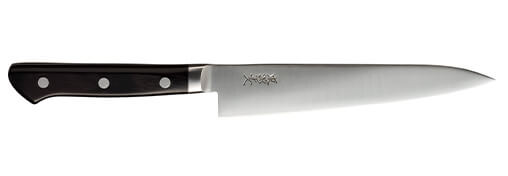Category包丁の種類

Santoku knife
(General purpose kitchen knife)
It is a general purpose knife made for home cooks to cut meat, vegetables and fish. Santoku has a thin and wide blade which is slightly curved to the tip. The shape is more like between Gyuto and Nakiri. It is often used for chopping and also slicing meat and sashimi in the home kitchens.
It is not good for cutting hard materials such as fish bones or frozen foods so that Deba or the other special knives should be used.
Details

Nakiri knife
A double-ground knife for cutting vegetables that has been popular at home for a long time.
The wide square blade is also suitable for scooping chopped vegetables, and is convenient for transferring ingredients from the cutting board to the pot or bowl.
The length of the blade is measured from the chin to the tip because of no Machi part.
Details

Sashimi knife
It is important to slice Sashimi with one stroke so as not to lose the freshness and the taste.
It is also widely used for cleaning slender fish, filleting, skinning and plating, and cutting into food and decorative carving by using the tip of the knife. The length of the blade is measured between the Machi (not the Ago) and the tip.
Details

Deba knife
t is a standard type of Japanese traditional knife that is used for fish and meat preparation. It is mainly used for cleaning and filleting fish, cutting through bones and dressing poultry.
It is constructed with a thick spine with a single-ground edge. From the heel to the less middle part of the blade is roughly used for chopping and cutting through hard bones. The rest of the part is used for cleaning and filleting. The blade length is measured between the Machi (not the Ago) and the tip.
Details

Kaisaki knife
The blade is narrower and thinner than Ko Deba. It is one of Deba knives that is similar to the much smaller Yanagiba.
Although it is used for cleaning clalms as its name “Kai”(clams), it is useful to clean small fish such as Kisu(Japanese whiting) and Megochi(Big-eyed flathead) and prepare fish with Ikijime technique (to drain blood from th live fish to keep it fresh).
The blade length is measuerd between the Machi (not the Ago) and the tip.
Details

Paring knife
It is a general purpose knife whose shape looks like a smaller Gyuto with a thin blade.
It is used for small intricate work such as peeling fruits and rounding off corners because of being small and handy.
So it is also called a “Fruits knife”.
It is often used for cleaning fish and meat with the advantage of the thin blade and the size for handling as well.
Details